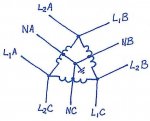JDBrown
Senior Member
- Location
- California
- Occupation
- Electrical Engineer
Okay, so this is one of those cases where (to paraphrase an old saying), rather than remaining silent and being thought a fool, I'm going to open my mouth and remove all doubt.  But that's how I learn.
But that's how I learn.
Is there a good reason why we can't take a 3 Phase Delta-Delta transformer with 240V secondary, center-tap all three windings, ground all the center-taps, and use it to feed three 120/240V single phase panelboards? We were discussing this at work this morning, and it seems to me that there's something wrong with the idea, but I can't seem to pinpoint what it is. Thoughts?

Is there a good reason why we can't take a 3 Phase Delta-Delta transformer with 240V secondary, center-tap all three windings, ground all the center-taps, and use it to feed three 120/240V single phase panelboards? We were discussing this at work this morning, and it seems to me that there's something wrong with the idea, but I can't seem to pinpoint what it is. Thoughts?




